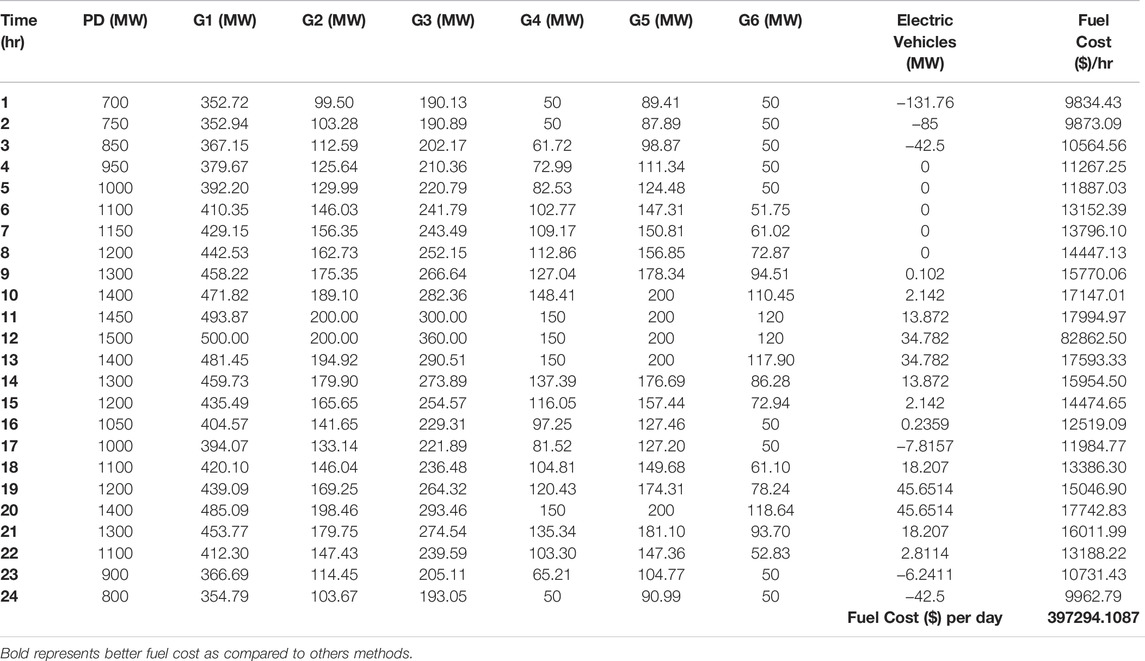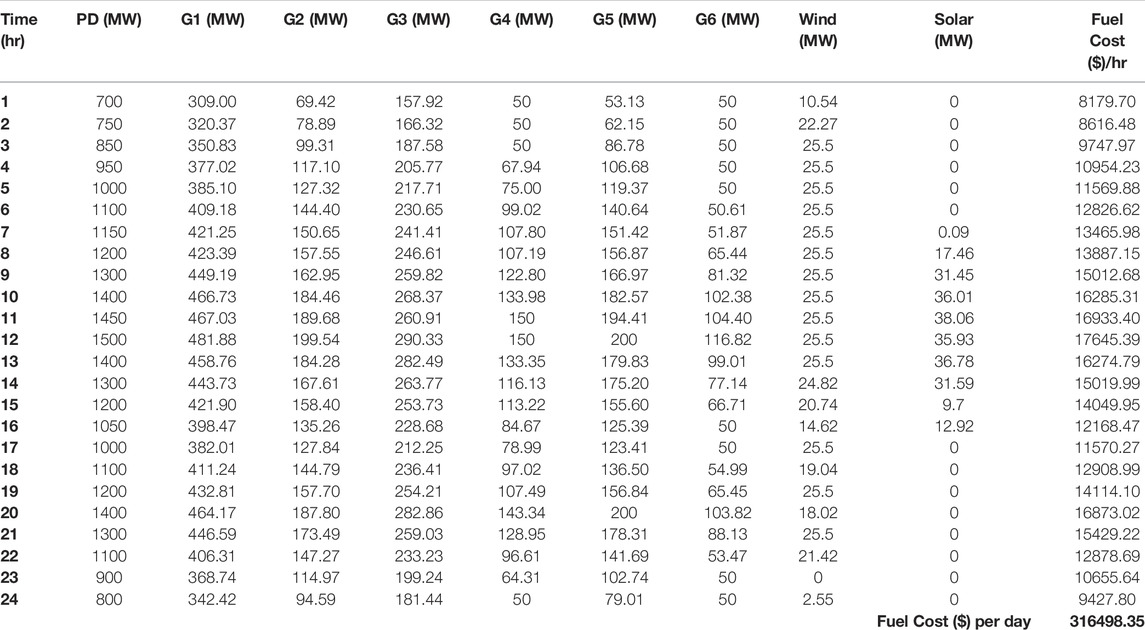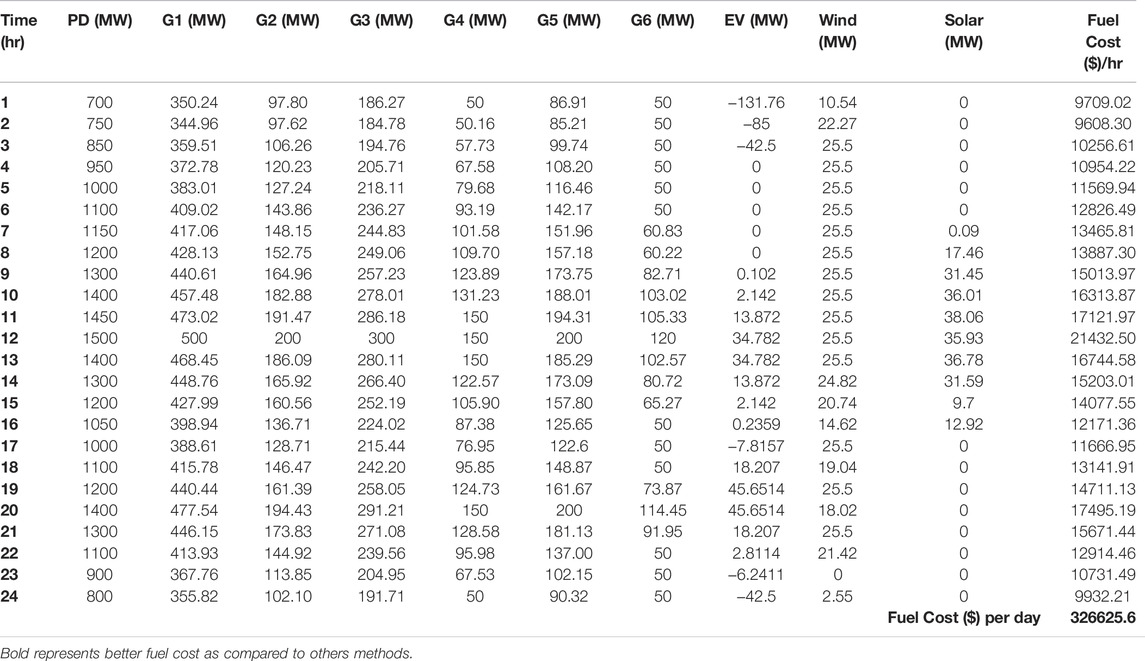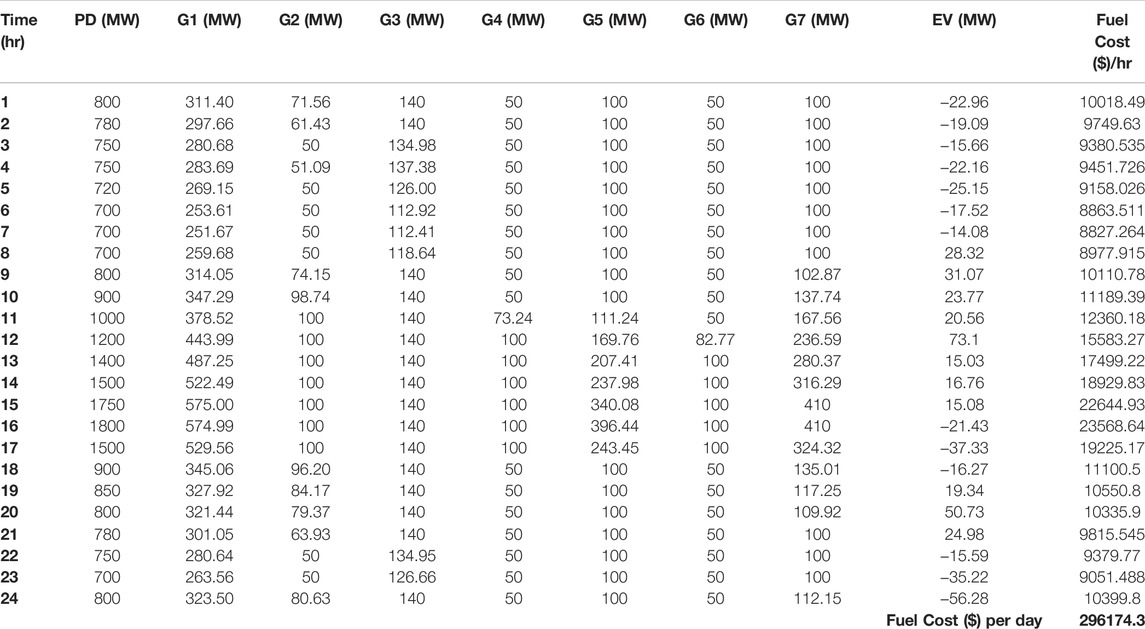- 1Provincial Key Laboratory of Informational Service for Rural Area of Southwestern Hunan, Shaoyang University, Shaoyang, China
- 2School of Computer Science and Engineer, Central South University, Changsha, China
- 3College of Physics and Electronics, Central South University, Changsha, China
The electricity sector has encountered several economic challenges in recent years. Increasing the expense of fossil fuels and environmental legislation such as the Kyoto Protocol and the Low Carbon Transition Plan have compelled governments to use renewable energy sources (RESs) more widely. In the proposed research, the dynamic economic load dispatch problem has been solved using improved chimp optimizer algorithm. The test systems consisting of 6, 7 and 10-unit generators has been taken into consideration along with significant contribution of renewable energy sources for effective research studies. The test systems has been evaluated for different cases considering renewable energy sources and electric vehicles using proposed algorithms. Experimentally, it has been observed that proposed optimizer yields better results as compared to other recently proposed optimizers.
1 Introduction
In recent years, the electrical power sector has faced a slew of economic issues which evoked a thought in Governments to encourage in adopting nonconventional energy sources noticing that the cost of fossil fuels has risen, the amount of fossil fuels has decreased, and the amount of Green House Gases (GHGs) emissions has increased. The Plug-in Electric Vehicles (PEVs) are a hybrid of Plug-in Hybrid Electric Vehicles (PHEVs) and Electric Vehicles (EVs) with a Vehicle to Grid (V2G) facility that looks to be a viable solution to the problem of GHG emissions. In (Kintner-Meyer et al., 2010) the impact of PEVs on the electrical system’s overall economics and emissions is explained in depth. The benefits of PEVs have been discussed in (Kempton and Tomić, 2005a), (Kempton and Tomić, 2005b). The available energy from PEVs has been wisely planned in (Hutson et al., 2008). The effect of integrating PEVs in the power system for charging (G2V) and auxiliary backing (V2G) to the grid was detailed in (Gholami et al., 2014). RESs and PEVs are discussed in depth in (IEEE Std, 2011). The impact of PEVs/PHEVs on a power system, as well as the integration of RESs into that system, is explored in (Aghaei et al., 2016). The use of RESs by GVs to reduce the price and emissions in a power system was explored in (Saber and Venayagamoorthy, 2010).
Safari (2018) described a clear distinction between the mainstream of BEVs and a hypothetical group of BEVs that are technically on a par with internal combustion vehicles (ICVs). Chen et al. (2015) presented an improved particle swarm optimization for engine/motor hybrid electric vehicles to develop an online suboptimal energy management system. Richardson (2013) described to considerably reduce carbon emissions from both power generation and transportation sectors by offering the potential of electric vehicles and renewable energy sources. Manzetti and Mariasiu (2015) presented an assessment of green chemistries as novel green energy sources for the electric vehicle and microelectronics portable energy landscape which provides a cradle-to-grave analysis of the emerging technologies in the transport sector. Hu et al. (2016) examined the role of renewable energy and power train optimization in minimizing daily carbon emissions of plug-in hybrid vehicles. Li et al. (2017) presented India’s ability to finance its ambitious renewable energy targets hinges on three significant factors. The first is based on how its regulatory framework can make the market attractive to finance providers. Second is in the context of effective implementation of RE policies. (Lopez-Behar et al., 2018, 2019) described the challenges and decision-making processes involved in the installation of EV charging infrastructure in Multi-Unit Residential Buildings in BC, from the perspective of different stakeholders. Yong et al. (2015) provided in-depth analyses on the current state, effects, and potential of EV deployment, as well as the most recent advancements in EV technology. Implementation of an incentive-based strategy to reduce the cost of EV purchases, the development of charging infrastructure, and improved public knowledge of environmental issues are all facilitators for expanded EV adoption (Li et al., 2021a), (Li et al., 2021b). Xu et al. (2015) presented a report on the multi-objective optimization problem of power train parameters for a predefined driving cycle regarding fuel economy and system durability. Yang et al. (2017) developed a revolutionary energy management technique for plug-in hybrid electric buses that optimizes the equivalent factor of each driving cycle segment. Liu et al. (2015) described the penetration of EVs is reshaping the transportation system. Clement-Nyns et al. (2011) presented PHEVs as they can provide storage to take care of the excess of produced energy and use it for driving or release into the grid at a later time would be a good combination. Tan et al. (2016) presented the optimization techniques to achieve different vehicle to grid objectives while satisfying multiple constraints and reviews the framework, benefits and challenges of vehicle to grid technology. Mwasilu et al. (2014) presented a review of the recent research and forecasting of electric vehicles (EVs) interaction with smart grid portraying the future electric power system model. The concept goal of the smart grid along with the future deployment of the EVs puts forward various challenges in terms of electric grid infrastructure, communication and control. Krishna et al. (2021a), (Krishna et al., 2021b) has developed two recent variants of pattern search algorithm to improve the local search capability of the existing Harris hawks optimizer and slime mould algorithm and had suggested to solve the economic load dispatch as future prospective. Arora et al. (2020) presented optimization methodologies for testing the Load Frequency Control for Interconnected multi area power system in smart grids. Nandi and Kamboj (2020) presented the a new solution approach for Profit Based Unit Commitment Problem Considering PEVs/BEVs and Renewable Energy Sources. Following an intensive review on advanced smart metering and communication infrastructures, the strategy for integrating the EVs into the electric grid is presented.
2 Problem Formulation
The basic purpose of single-area economic and dynamic load dispatch is to lower total fuel costs of power generating units while satisfying different constraints. The entire objective function for economic dispatch, taking into account PEVs, BEVs, and renewable energy sources, is as follows:
The dispatch of power generating units for ‘H’ Hours may be represented as:
The actual mathematical formulation for Dynamic Dispatch was expressed by this Eq. (1b). For time-varying load demand, the hour “h” can be changed from 1 to H hours.
2.1 Power Balance Constraint
The entire generation from all generators must meet the overall power demand and real power loss of the system.
where,
In Eq. (2) renewable energy source is integrated with generating units.
where,
Case-1: During ChargingThe following Eq. (4) can be used to calculate the power balance constraints for PEVs, BEVs, and RES during the charging phase.
Case-2: During DischargingThe power balancing constraints for PEVs, BEVs, and RES during the discharging phase may be mathematically stated using the following eqns:
Where,
if
The expanded version of the above equation may be represented as:
2.2 Generator Limit Constraint
Each generator’s actual power output must be kept within its respective upper and lower operating limitations.
where,
2.3 Ramp Rate Limits
The output power of the generating unit is boosted between the lower and upper limits of active power generation.
1) As a result of an increase in generated power,
2) By reducing the amount of generated power,
As a result, the generator ramp rate is represented in the equation below.
where,
3 Test Systems
The single area dynamic load dispatch problem has been described, considering plug-in electric vehicles, battery electric vehicles and renewable energy sources along with the system and physical limits of thermal generating units. The dynamic load dispatch problem has been solved and tested for 6-unit, 7-unit, and 10-unit systems. To validate the proposed algorithms, standard power systems consisting 6, 7, and 10 generating units have been considered.
4 Results and Discussion
Proposed algorithms such as chimp optimizer, slime mould, improved chimp optimizer and improved slime mould algorithms fruitfully handle the electric power system’s single area dynamic load dispatch problem. This section looks at how to solve the single area dynamic load dispatch problem using plug-in electric vehicles, renewable energy sources and combined plug-in electric vehicles and renewable energy sources for 6, 7 and 10 generating units, respectively. On an Intel corei3 processor laptop with a 7th generation CPU and 8GB RAM, the proposed approaches were evaluated using the MATLAB R2016a programme. For comparison reasons, the efficacy of the proposed algorithms is compared to that of other well-known evolutionary, heuristics, and meta-heuristics search techniques.
4.1 Dynamic Load Dispatch Using Chimp Optimizer Algorithm
In order to verify the chimp optimizer algorithm, the algorithm is accepted by search agents 50, 500 iterations and 30 maximum runs. The effectiveness of the proposed algorithm is tested on a variety of test systems, including plug-in electric vehicles, renewable energy sources, and combined plug-in electric vehicles and renewable energy sources as detailed in this section. This approach has been tested on a 6-unit, 7-unit and 10-unit test system.
4.1.1 Six Generator Test System (SADLD With EVs)
Chimp optimizer algorithm is suggested to get optimized outcomes for dynamic load dispatch with the effect of EVs as V2G and G2V. A six-generator test system is studied, with no valve point loading impact and a loss coefficient matrix of zero (Debnath et al., 2015). Table 1 displays that the fuel price is 397294.1087 $/day using the chimp optimizer algorithm.

TABLE 1. 6-unit generator Dynamic Load Dispatch with EVs (without valve point loading effect without losses) using Chimp optimizer Algorithm.
4.1.2 Six Generator Test System (SADLD With RES)
Chimp optimizer algorithm is suggested to get optimized outcomes for dynamic load dispatch with the effect of RES. A six generator test system without valve point loading effect, with loss coefficient matrix as zero is considered (Debnath et al., 2015). The renewable energy sources wind and solar are incorporated. Table 2 displays that the fuel price is 316498.35 $/day using the chimp optimizer algorithm.

TABLE 2. 6-unit generator Dynamic Load Dispatch with RES (without valve point loading effect without losses) using Chimp optimizer algorithm.
4.1.3 Six Generator Test System (SADLD With EVs and RES)
Chimp optimizer algorithm is suggested to get optimized outcomes for dynamic load dispatch with the combined effect of EVs and RES. A six generator test system without valve point loading effect, with loss coefficient matrix as zero is considered (Debnath et al., 2015). The Electric vehicles and renewable energy sources wind and solar are incorporated. Table 3 displays that the fuel price is 326625.6 $/day using the chimp optimizer algorithm.

TABLE 3. 6-unit generator Dynamic Load Dispatch with EVs and RES (without valve point loading effect without losses) using Chimp optimizer algorithm.
4.1.4 Seven Generator Test System (SADLD With EVs)
Chimp optimizer algorithm is suggested to get optimized outcomes for dynamic load dispatch with the effect of EVs as V2G and G2V. A seven generator test system without valve point loading effect, with loss coefficient matrix as zero is considered (Tariq et al., 2020), (Gholami et al., 2014). Table 4 displays that the fuel price is 296174.3087 $/day using the chimp optimizer algorithm.

TABLE 4. 7-unit generator Dynamic Load Dispatch with EVs (without valve point loading effect without losses) using Chimp Optimizer Algorithm.
5 Conclusion
In the proposed research, dynamic load dispatch problem has been solved using chimp optimizer algorithm. The test systems consisting of 6, 7 and 10-unit generators when incorporated with only electric vehicles, only renewable energy sources, and combined electric vehicles and renewable energy sources have been successfully tested using proposed algorithms. The results of the test systems with EVs and RES have been compared without EVs and RES results. The simulation results show that the suggested methods found satisfactory load dispatch at a reasonable cost. These dominating algorithms may also be used to solve the problem of multi-area dynamic load dispatch in electrical power networks.
Data Availability Statement
The original contributions presented in the study are included in the article/Supplementary Material, further inquiries can be directed to the corresponding author.
Author Contributions
JX put forward the main research points; AL, YQ, GX, and YT completed manuscript writing and revision; AL, YQ, and GX completed simulation research; YQ, GX, and YT collected relevant background information; AL, GX, and YT revised grammar and expression. All authors contributed to manuscript revision, read, and approved the submitted version.
Conflict of Interest
The authors declare that the research was conducted in the absence of any commercial or financial relationships that could be construed as a potential conflict of interest.
Publisher’s Note
All claims expressed in this article are solely those of the authors and do not necessarily represent those of their affiliated organizations, or those of the publisher, the editors and the reviewers. Any product that may be evaluated in this article, or claim that may be made by its manufacturer, is not guaranteed or endorsed by the publisher.
References
Aghaei, J., Nezhad, A. E., Rabiee, A., and Rahimi, E. (2016). Contribution of Plug-In Hybrid Electric Vehicles in Power System Uncertainty Management. Renew. Sustain. Energy Rev. 59 (99), 450–458. doi:10.1016/j.rser.2015.12.207
Arora, K., Kumar, A., Kamboj, V. K., Prashar, D., Jha, S., Shrestha, B., et al. (2020). Optimization Methodologies and Testing on Standard Benchmark Functions of Load Frequency Control for Interconnected Multi Area Power System in Smart Grids. Mathematics 8 (6), 980. doi:10.3390/math8060980
Chen, S.-Y., Hung, Y.-H., Wu, C.-H., and Huang, S.-T. (2015). Optimal Energy Management of a Hybrid Electric Powertrain System Using Improved Particle Swarm Optimization. Appl. Energy 160, 132–145. doi:10.1016/j.apenergy.2015.09.047
Clement-Nyns, K., Haesen, E., and Driesen, J. (2011). The Impact of Vehicle-To-Grid on the Distribution Grid. Electr. Power Syst. Res. 81 (1), 185–192. doi:10.1016/j.epsr.2010.08.007
Debnath, U. K., Ahmad, I., Habibi, D., and Saber, A. Y. (2015). Energy Storage Model with Gridable Vehicles for Economic Load Dispatch in the Smart Grid. Int. J. Electr. Power & Energy Syst. 64, 1017–1024. doi:10.1016/j.ijepes.2014.09.004
Gholami, A., Ansari, J., Jamei, M., and Kazemi, A. (2014). Environmental/economic Dispatch Incorporating Renewable Energy Sources and Plug‐in Vehicles. IET Generation, Transm. Distribution 8 (12), 2183–2198. doi:10.1049/iet-gtd.2014.0235
Hu, X., Zou, Y., and Yang, Y. (2016). Greener Plug-In Hybrid Electric Vehicles Incorporating Renewable Energy and Rapid System Optimization. Energy 111, 971–980. doi:10.1016/j.energy.2016.06.037
Hutson, C., Venayagamoorthy, G. K., and Corzine, K. A. (2008). “Intelligent Scheduling of Hybrid and Electric Vehicle Storage Capacity in a Parking Lot for Profit Maximization in Grid Power Transactions,” in 2008 IEEE Energy 2030 Conf. ENERGY 2008, Atlanta, GA, USA, 17-18 Nov. 2008, 1–8. doi:10.1109/energy.2008.47810512008
IEEE Std (2011). .2030-2011, IEEE Guide For Smart Grid Interoperability Of Energy Technology And Information Technology Operation With the Electric Power System (EPS), End-Use Appl. Loads, September
Kempton, W., and Tomić, J. (2005). Vehicle-to-grid Power Fundamentals: Calculating Capacity and Net Revenue. J. Power Sources 144 (1), 268–279. doi:10.1016/j.jpowsour.2004.12.025
Kempton, W., and Tomić, J. (2005). Vehicle-to-grid Power Implementation: From Stabilizing the Grid to Supporting Large-Scale Renewable Energy. J. Power Sources 144 (1), 280–294. doi:10.1016/j.jpowsour.2004.12.022
Kintner-Meyer, M., Nguyen, T. B., Jin, C., Balducci, P., and Secrest, T. (2010). “Impact Assessment of Plug-In Hybrid Vehicles on the U.S. Power Grid,” in The 25th World Battery, Hybrid and Fuel Cell Electric Vehicle Symposium & Exhibition, Shenzhen, China, November 5–9, 2010 Vol. EVS25, 1–6.
Krishna, A. B., Saxena, S., and Kamboj, V. K. (2021). A Novel Statistical Approach to Numerical and Multidisciplinary Design Optimization Problems Using Pattern Search Inspired Harris Hawks Optimizer. Neural Comput. Applic 33, 7031–7072. doi:10.1007/s00521-020-05475-5
Krishna, A. B., Saxena, S., and Kamboj, V. K. (2021). A Novel Statistical Approach to Numerical and Multidisciplinary Design Optimization Problems Using Pattern Search Inspired Harris Hawks Optimizer. Neural Comput. Applic 33 (12), 7031–7072. doi:10.1007/s00521-020-05475-5
Li, H., Deng, J., Feng, P., Pu, C., Arachchige, D. D. K., and Cheng, Q. (2021). Short-Term Nacelle Orientation Forecasting Using Bilinear Transformation and ICEEMDAN Framework. Front. Energy Res. 9, 780928. doi:10.3389/fenrg.2021.780928
Li, H., Deng, J., Yuan, S., Feng, P., and Arachchige, D. D. K. (2021). Monitoring and Identifying Wind Turbine Generator Bearing Faults Using Deep Belief Network and EWMA Control Charts. Front. Energy Res. 9, 799039. doi:10.3389/fenrg.2021.799039
Li, L., Zhou, L., Yang, C., Xiong, R., You, S., and Han, Z. (2017). A Novel Combinatorial Optimization Algorithm for Energy Management Strategy of Plug-In Hybrid Electric Vehicle. J. Frankl. Inst. 354 (15), 6588–6609. doi:10.1016/j.jfranklin.2017.08.020
Liu, L., Kong, F., Liu, X., Peng, Y., and Wang, Q. (2015). A Review on Electric Vehicles Interacting with Renewable Energy in Smart Grid. Renew. Sustain. Energy Rev. 51, 648–661. doi:10.1016/j.rser.2015.06.036
Lopez-Behar, D., Tran, M., Froese, T., Mayaud, J. R., Herrera, O. E., and Merida, W. (20182019). Charging Infrastructure for Electric Vehicles in Multi-Unit Residential Buildings: Mapping Feedbacks and Policy Recommendations. Energy Policy 126, 444–451. doi:10.1016/j.enpol.2018.10.030
Manzetti, S., and Mariasiu, F. (2015). Electric Vehicle Battery Technologies: From Present State to Future Systems. Renew. Sustain. Energy Rev. 51, 1004–1012. doi:10.1016/j.rser.2015.07.010
Mwasilu, F., Justo, J. J., Kim, E.-K., Do, T. D., and Jung, J.-W. (2014). Electric Vehicles and Smart Grid Interaction: A Review on Vehicle to Grid and Renewable Energy Sources Integration. Renew. Sustain. Energy Rev. 34, 501–516. doi:10.1016/j.rser.2014.03.031
Nandi, A., and Kamboj, V. K. (2020). A New Solution to Profit Based Unit Commitment Problem Considering PEVs/BEVs and Renewable Energy Sources. E3S Web Conf. 184, 01070. doi:10.1051/e3sconf/202018401070
Richardson, D. B. (2013). Electric Vehicles and the Electric Grid: A Review of Modeling Approaches, Impacts, and Renewable Energy Integration. Renew. Sustain. Energy Rev. 19, 247–254. doi:10.1016/j.rser.2012.11.042
Saber, A. Y., and Venayagamoorthy, G. K. (2010). Efficient Utilization of Renewable Energy Sources by Gridable Vehicles in Cyber-Physical Energy Systems. IEEE Syst. J. 4 (3), 285–294. doi:10.1109/jsyst.2010.2059212
Safari, M. (2018). Battery Electric Vehicles: Looking behind to Move Forward. Energy Policy 115 (December 2017), 54–65. doi:10.1016/j.enpol.2017.12.053
Tan, K. M., Ramachandaramurthy, V. K., and Yong, J. Y. (2016). Integration of Electric Vehicles in Smart Grid: A Review on Vehicle to Grid Technologies and Optimization Techniques. Renew. Sustain. Energy Rev. 53, 720–732. doi:10.1016/j.rser.2015.09.012
Tariq, F., Alelyani, S., Abbas, G., Qahmash, A., and Hussain, M. R. (2020). Solving Renewables-Integrated Economic Load Dispatch Problem by Variant of Metaheuristic Bat-Inspired Algorithm. Energies 13 (23), 6225. doi:10.3390/en13236225
Xu, L., Mueller, C. D., Li, J., Ouyang, M., and Hu, Z. (2015). Multi-objective Component Sizing Based on Optimal Energy Management Strategy of Fuel Cell Electric Vehicles. Appl. Energy 157, 664–674. doi:10.1016/j.apenergy.2015.02.017
Yang, C., Du, S., Li, L., You, S., Yang, Y., and Zhao, Y. (2017). Adaptive Real-Time Optimal Energy Management Strategy Based on Equivalent Factors Optimization for Plug-In Hybrid Electric Vehicle. Appl. Energy 203, 883–896. doi:10.1016/j.apenergy.2017.06.106
Keywords: dynamic economic load dispatch, chimp optimizer, meta-heuristics search algorithms, renewable energy sources, green house gase
Citation: Xu J, Liu A, Qin Y, Xu G and Tang Y (2022) A Cost Effective Solution to Dynamic Economic Load Dispatch Problem Using Improved Chimp Optimizer. Front. Energy Res. 10:952354. doi: 10.3389/fenrg.2022.952354
Received: 25 May 2022; Accepted: 24 June 2022;
Published: 26 July 2022.
Edited by:
Xun Shen, Tokyo Institute of Technology, JapanReviewed by:
Vikram Kamboj, Lovely Professional University, IndiaHaoyun Shi, Great Wall Motor, China
Copyright © 2022 Xu, Liu, Qin, Xu and Tang. This is an open-access article distributed under the terms of the Creative Commons Attribution License (CC BY). The use, distribution or reproduction in other forums is permitted, provided the original author(s) and the copyright owner(s) are credited and that the original publication in this journal is cited, in accordance with accepted academic practice. No use, distribution or reproduction is permitted which does not comply with these terms.
*Correspondence: Yibo Tang, NjI2MzIzMzIwQHFxLmNvbQ==
 Jianming Xu
Jianming Xu Anfeng Liu2
Anfeng Liu2 Yibo Tang
Yibo Tang